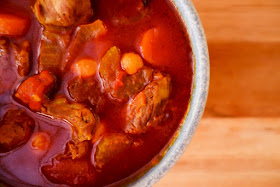 |
| A cider-spiked cherry-studded mango smoothie. A delicious seasonal drink for New Year's Eve in Australia! |
I am no stranger to making cocktails that masquerade as smoothies. See: this raspberry-cucumber cocktail from 2011, and this lemon-jasmine-banana cocktail that followed in 2012. What can I say? I'm a smoothie fanatic, and I'm a lightweight when it comes to alcohol. So cocktail-smoothies, or smoothie-cocktails, well... they just work, for me. They're my perfect festive holiday drink!
Mangoes and cherries always appear prominently in the shops around Christmas and New Year's in Australia, so this time around, my creation is a fruit-a-licious cherry-studded mango cocktail with a subtle hint of alcoholic effervescence from apple cider (hard cider, for my North American readers). I downed the whole glass, and after the initial refreshing hit of coolness, it gave me just the right amount of warm and fuzzy, with no ill effects. Success!
 |
| Mango-cherry cocktail-smoothie. |
mango-cherry cocktail-smoothie
(serves 1)
1 cup mango
6 cherries, pitted (more for a stronger cherry flavour)
1 teaspoon lime juice
1/2 cup hard apple cider or sparkling wine
Blend mango, cherries and lime juice with 1/2 cup water and 2 ice cubes. Pour into a glass, use a nice fancy one if you're feeling sophisticated. Top up with apple cider or sparkling wine. Sip it slowly or quaff it quickly - it's up to you!
Note 1: I used frozen diced mango and fresh cherries. I recommend that at least some of the fruit you use in this smoothie-cocktail be of the frozen variety, to ensure the end result is pleasingly icy-cold.
Note 2: If you prefer a non-alcoholic drink, feel free to use sparkling apple juice instead of apple cider to make this a mocktail!
Note 3: If you require this to be vegan-friendly, make sure that the alcohol you use has not been processed with animal products.





















































